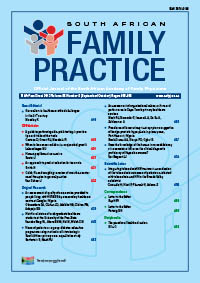Does the knowledge of the human immunodeficiency virus serostatus influence the clinical diagnostic proficiency of Kaposi’s sarcoma?
Keywords:
Kaposi’s sarcoma, mimics, clinical diagnosis, HIV
Abstract
Objectives: Kaposi’s sarcoma is an acquired immunodeficiency syndrome (AIDS)-defining illness. A spectrum of non-Kaposi’s sarcoma clinical and histopathological mimickers contributes to the potential over- or underdiagnosis of Kaposi’s sarcoma. The aim of this audit was to investigate the clinical diagnostic accuracy of Kaposi’s sarcoma and to find out whether or not knowledge of the human immunodeficiency virus (HIV) serostatus influenced the clinical diagnostic accuracy. Design: Cross-sectional study of 511 mucocutaneous biopsies. Settings and subjects: All the biopsies were from African patients from the Limpopo province. The HIV seropositive status was known in 327 cases (64.2%). The clinical diagnosis, provided in 369 cases (72.2%) was compared with the biopsy. A Kaposi’s sarcoma herpesvirus-positive immunophenotype on biopsy served as the diagnostic gold standard. Outcome measure: Concordance or discordance between the clinical provisional diagnosis and the histopathological gold standard. Results: The rate of provisional clinical diagnosis of non- Kaposi’s sarcoma in biopsy-proven Kaposi’s sarcoma was 18.1% in HIV-positive, and 39.5% in HIV unknown, serostatus (chi-square 11.8, p-value = 0.0006). The concordance between the clinical diagnosis and biopsy was 76.5% in the HIV-positive, and 49.9% in the HIV-unknown, cases (chi-square 16.9, p-value < 0.0001). Conclusion: Knowledge of the patient’s serostatus significantly improved the clinical diagnostic accuracy of Kaposi’s sarcoma. Biopsy remains the diagnostic gold standard.
Published
2013-01-15
Section
Original Research
By submitting manuscripts to SAFP, authors of original articles are assigning copyright to the South African Academy of Family Physicians. Copyright of review articles are assigned to the Publisher, Medpharm Publications (Pty) Ltd, unless otherwise specified. Authors may use their own work after publication without written permission, provided they acknowledge the original source. Individuals and academic institutions may freely copy and distribute articles published in SAFP for educational and research purposes without obtaining permission.

